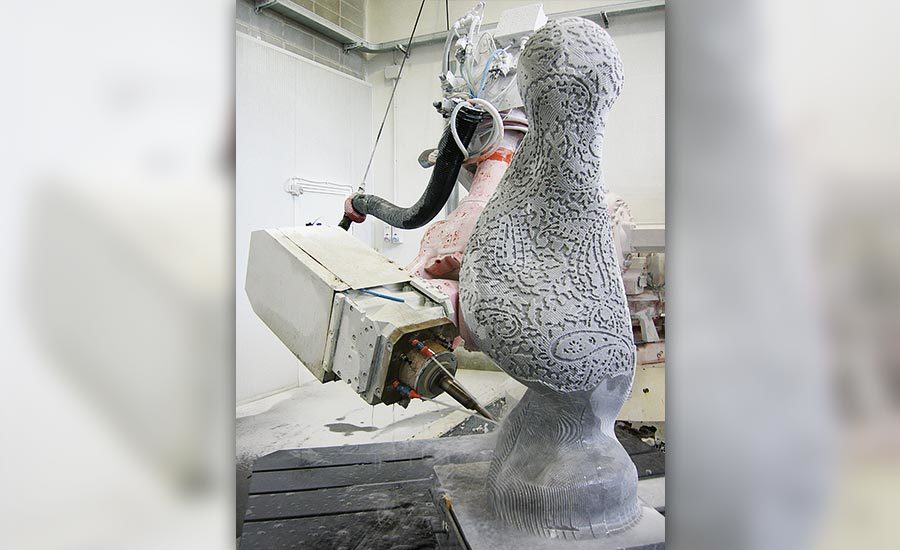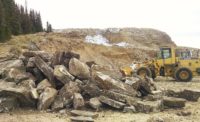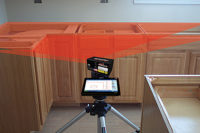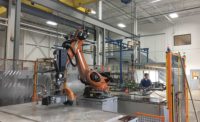High in the Natural Park of the Apuan Alps, near Lago Di Gramolazzo and the historical center of the Italian village of Gramolazzo, a group of artists, architects and designers gather to spend a month sculpting marble with robots. The annual symposium was conceived by Jon Isherwood, sculptor and president of The Digital Stone Project, and in partnership with Garfagnana Innovazione, an initiative born in 2011 by the municipality of Minucciano with the objective of developing a new fabrication facility to process local stone materials. The Digital Stone Project is described as “bridging art and technology by creating new opportunities for artists to engage in state-of-the-art digital tools for the realization of innovative works of art in stone.”
A long-time sculptor, with work widely exhibited in public museums and private galleries around the U.S., Canada and Europe, Isherwood is a professor at Bennington College in Bennington, VT, and has a studio in Hudson, NY. It was when he first started working with stone over a decade ago that he became interested in the role technology plays in creating sculptural forms. Before working with stone, he had worked in clay, wood, steel and concrete, initially beginning his career as a textile designer.
“I had begun developing sculpture digitally at the Johnsons Atelier digital stone division in Hamilton, NJ,” he said. “Johnson Atelier had developed a service for artists in early 2000, but decided after a couple of years they didn’t want to continue. I had just started working with stone and CNC technologies and using their facilities. There were about five of us who had begun to think about these types of processes. So I and four others decided to save the operation rather than see the machinery sold off. I raised the money necessary and set up a not-for-profit organization called the Digital Stone Project.
“As a not-for-profit, you are obligated to have workshops and educate,” Isherwood went on to explain. “In 2009, through varying pressures, we had no option but to split the organization up. I took on the responsibility of the educational side, as I was interested in that and technology.”
The conception of Garfagnana Innovazione
Garfagnana Innovazione was established to foster employment and ecomonic development in the Garfagnana region, engaging advanced technology in stone processing in order to enhance the manual stoneworking skills that are traditionally used in these territories.
“They have a unique story,” said Isherwood. “Garfagnana Innovazione was founded about six or seven years ago. Stefano Coiai, CEO, had ideas to rejuvenate the stone industry in his home town. It had been a very active area for many years, but the migration of stone processing and direct exportation of marble had resulted in the closure of many local facilities. Stefano, whose father was a quarryman, thought about how to revitalize it. He successfully secured regional and European Union money and built the facility.”
Isherwood went on to explain Garfagnana Innovazione comprises three intiatives. “One is education,” he said. “It is their responsibility to educate to traditional and contemporary stone processing — whether regionally or internationally. Second, they were to create incubators that would be industrial shop space for people to come and start a business. There is a waterjet company that just moved in and is doing high-end mosaic stonework. Another space is taken by a sculptor providing high-end finishing work. Thirdly, Garfagnana Innovazione must become commercially viable, which it has.”
Today, there is a highly qualified technical staff in place programing and operating CNC robotic stone-carving equipment, opening the field for collaboration with other people interested in the project. In the headquarters, there are 10 fully equipped spaces, which are assigned every three years to new companies and artisans of the stone industry at competitive costs to help the start-up status of their activities. Garfagnana Innovazione offers highly innovative services, both in the research and consulting for the materials and fabrication processes. The major marble producers in the region are partners of Garfagnana Innovazione. They include:
- Acquabianca Srl
- Bianco Royal
- Cave Focolaccia Srl
- Cooperativa Apuana
- StoneOne
- The start of a partnership
“In 2011, I was in Italy and introduced to Garfagnana Innovazione,” said Isherwood. “I was amazed at their program and ambition for it. I said, ‘Let’s do something together.’ So for the last five years, we have organized the workshop every summer. Through application, 18 participants are selected, and for a month, stay at a local hotel and work in temporary studios. Our goal is to create a sustainable annual workshop, an annual exhibition schedule and grow a network of artists, designers and architects working with stone — both digitally and traditionally.”
Over the course of the month, each participant produces a sculpture that is carved with a seven-axis robot arm and finished by hand. Garfagnana Innovazione offers a unique opportunity to bring students, artists and arts educators together with the latest innovations in digital stone fabrication technologies and technicians. The workshop allows the development and execution of innovative, 3D, digitally developed projects.
“Garfagnana Innovazione partnered with quarries in the region so they can have direct access to material,” explained Isherwood. Participants have the opportunity to make a piece proportional of their choice, to a cubic meter and milling time allotted.
A once-in-a-lifetime experience
For many participants, this a rare opportunity to not only work in a state-of-the-art fabrication shop, but also a chance to experience Italian culture and all it has to offer.
“It has been through word of mouth only,” said Isherwood. “Our web page has application details. People submit proposals around December and from their proposal we help them develop STL files that can be exported to the technologists at Garfagnana Innovazione to discuss milling strategies. By the time they arrive in June, they have a form that is rough milled. Then they can finish it by hand.”
At the end of the workshop, there is always an exhibition for the participants work to be displayed. “We have a range of people,” said Isherwood. “Some are artists, architects, grad students and professors. There is encouragement for people if this is something they want to do. It is open to all who are interested in learning. For many of the students, it is the first time working in stone.
“There is a lot of help at the facility to instruct,” Isherwood went on to say. “I think all of us at some point in our life had a mentor. The Digital Stone Project is this and an opportunity to try something out and change ways of making and thinking. I feel strongly about that. That’s always my ambition for it — to challenge people to use a robot to carve something unique that could not be done otherwise. Find out what type of form and surfaces can be obtained from milling. I think the excitement to be in the mountains of Tuscany — absorbing that in a deep way — surrounded with the tradition of stone is exciting.”
A visit from MIA+BSI
The MIA+BSI: The Natural Stone Institute, in a partnership with IMM Carrara, sent a delegation to “White Carrara Downtown” from June 11 to 14, for factory and quarry tours. The trip kicked off at Garfagnana Innovazione where participants were given the opportunity to visit with the sculptors, view their works in progress and enjoy the local food and beverages.
“I’m fascinated by stone sculpture, and The Digital Stone Project combines CNC machinery, interesting baseline data and artists with varying degrees of experience to create some of the most beautiful stone art,” said Jeff Handley, MIA+BSI: The Natural Stone Institute member relations manager. “Having Jon tell the stories about how the data was derived and contributed to the sculptors’ art gives the sculptures another layer of depth to an already great story. It was a memorable start for our delegation; that went on to include multiple factories, a modern marble quarry and an ancient Roman quarry.”













